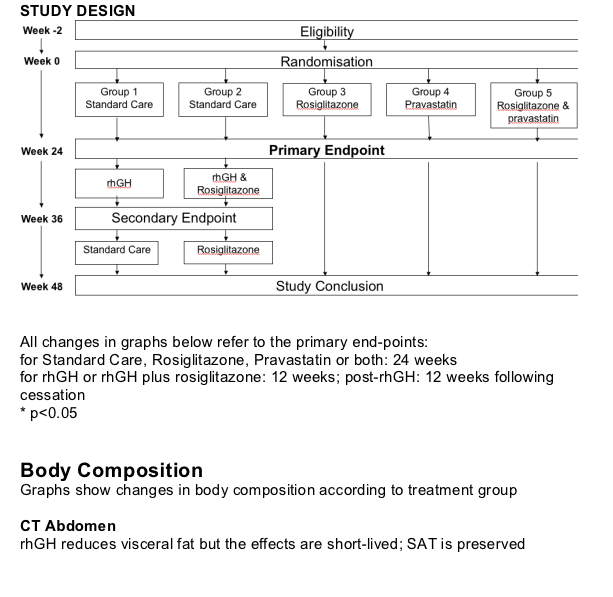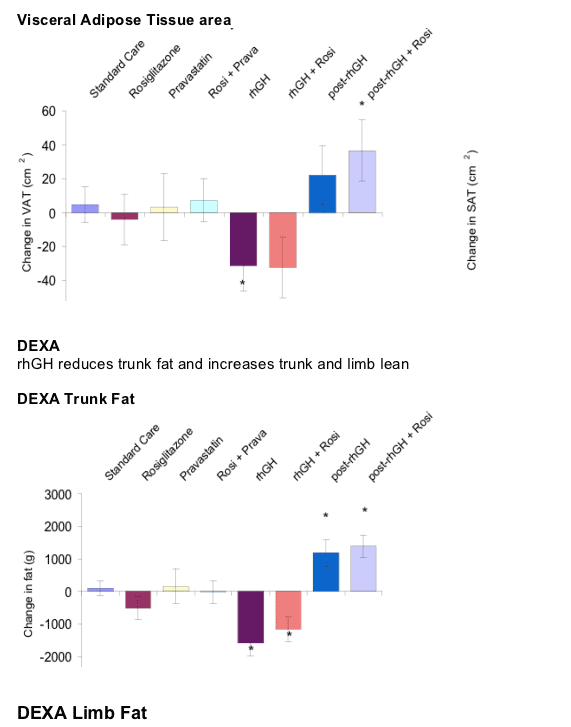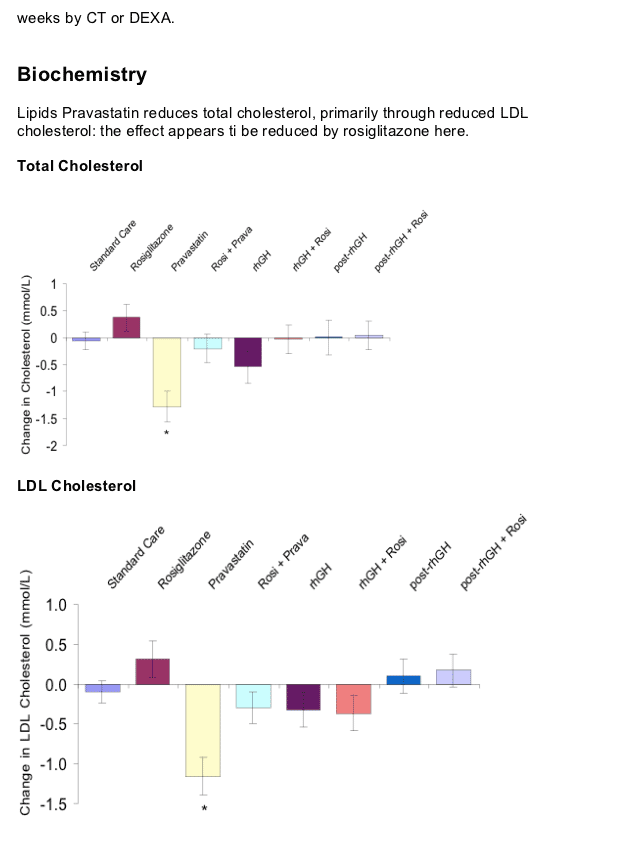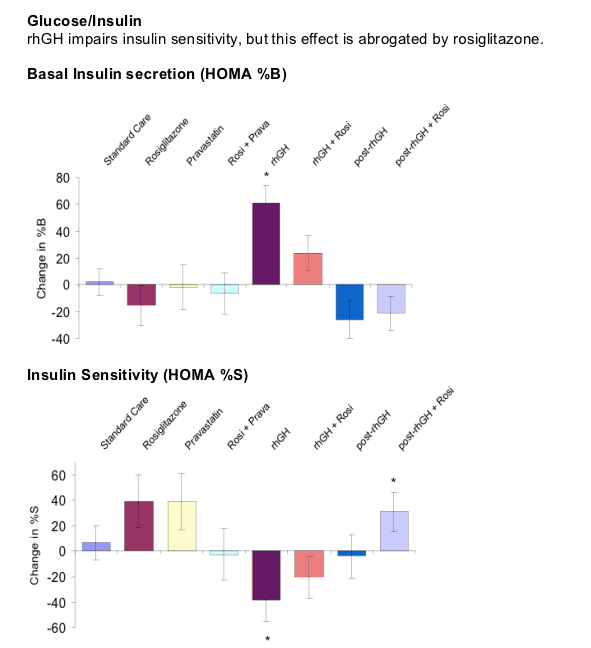 |
 |
 |
| |
Comparison of the Effects on Body Composition of Rosiglitazone, Pravastatin, and Growth Hormone Alone and in Combination in the HIV-associated Lipoatrophy Treatment (HALT) Study
|
| |
| |
Reported by Jules Levin
Lipodystrophy Workshop
San Francisco, Sept 2006
Brief Summary: This study was reported at the Lipo Wksp & ICAAC.
Aims
This study was designed to assess the impact of treatment with rosiglitazone, pravastatin and rhGH alone and in combination on body composition in HALS.
The combination of rhGH and rosiglitazone was included to test whether this might improve body composition without worsening insulin resistance.
Methods
60 HIV-infected men with HALS were randomized into 5 arms to receive daily therapy with: (1) pravastatin, 40mg, (2) rosiglitazone, 4 mg, or (3) pravastatin and rosiglitazone, for 48 weeks, or (4) recombinant human growth hormone (rhGH, Serostim, 2mg) or (5) rhGH and rosiglitazone for 12 weeks.
Assessments every 12 weeks included dual energy X-ray absorptiometry (DEXA), computed tomography (CT), biochemistry and clinical anthropometrics.
Pravastatin had a non-significant effect of increasing limb fat by DEXA and rosiglitazone had a non-significant effect of decreasing limb fat by DEXA. rhGH reduced visceral fat and increased lean tissue. The rhGH dose was 2 mg daily. The authors said "combining rhGH with rosiglitazone reduced some of the insulin resistance effects of rhGH and improved the speed of recovery of insulin sensitivity after cessation of rhGH. Prevastatin reduced tptal cholesterol and LDL-cholesterol.
D. C. MACALLAN1, S. MANDALIA 2, G. PANAYIOTAKOPOULOS 3, C. BALDWIN 2, G. J. MOYLE 2;
1St George's, Univ. of London, London, United Kingdom, 2Chelsea & Westminster Hosp., London, United Kingdom, 3St George's, Univ. fo London, London, United Kingdom.
Introduction
Several treatment options have been suggested for HIV-associated Lipodystrophy
Glitazones
-- Glitazones have been shown to improve insulin sensitivity in individuals with significant insulin resistance
-- Data on their effects on body composition have been conflicting
Statins
-- Statins are known to improve circulating lipids
-- There is some evidence that statins may influence body composition
Recombinant human growth hormone (rhGH)
-- rhGH is known to be anabolic and lipolytic
-- rhGH exacerbates insulin resistance





Conclusions
Rosiglitazone does not appear to be an effective treatment for altered body composition in HALS.
Pravastatin has minimal effects on body composition but improves lipid profile.
There is a suggestion that rosiglitazone may antagonise the effects of pravastatin.
rhGH effectively reduces visceral fat and increases lean tissue but most of the effect is short-lived and side-effects are still significant - the dose used here is lower than in some previous studies - 2mg per day still appears effective.
Combining rhGH with rosiglitazone reduces some of the insulin resistance effects of rhGH and improves the speed of recovery of insulin sensitivity after cessation of rhGH.
Comment
This study is only a relatively small pilot study. It demonstrates the difficulty in treating HALS and thus emphasises the importance of ART choice in HIV.
Further investigation of therapeutic approaches is warranted.
ABSTRACT
Background: Treatment options for HIV-associated Lipoatrophy (HALS) remain limited. Beyond switching to a thymidine NRTI-sparing regimen, few interventions have shown reliable benefit. Recently, increased limb fat with glitazones and statins have been reported. Growth hormone may have beneficial effects on body composition but exacerbates insulin resistance. We set out to investigate the effects of rosigkitazone, pravastatin, and groeth hormone, alone or in combination, as part of the HIV-associated Lipodystrophy Treatment (HALT) Study.
Methods: 60 HIV-infected men with HALS were randomized into 5 arms to receive daily therapy with: (1) pravastatin, 40mg, (2) rosiglitazone, 4 mg, or (3) pravastatin and rosiglitazone, for 48 weeks, or (4) recombinant human growth hormone (rhGH, Serostim, 2mg) or (5) rhGH and rosiglitazone for 12 weeks. Assessments every 12 weeks included dual energy X-ray absorptiometry (DEXA), computed tomography (CT), biochemistry and clinical anthropometrics.
Results: Neither pravastatin nor rosiglitazone, either alone or in combination affected measures of body composition by DEXA, CT or clinical criteria. rhGH resulted in significant reduction in visceral abdominal fat (-31 ± 15 cm2, 26%) by CT and reduced trunk fat (-1597 ± 383g, 27%) and increased trunk lean and limb lean (10% and 12% respectively) by DEXA after 12 weeks but the effects were reversed almost completely within 12 weeks of discontinuation. Adding rosiglitazone to rhGH treatment abrogated the insulin resistance seen with rhGH alone. Total and LDL cholesterol were reduced by pravastatin (by 1.3 ± 0.3 and 1.2 ± 0.2 mmol/L respectively) but were unaffected by other therapies.
Conclusions: Neither pravastatin nor rosiglitazone are effective therapies for body composition changes in HALS. rhGH is effective at reducing visceral fat and its deleterious effects on insulin resistance can be reduced by co-administration of rosiglitazone but its effects are short-lived.
|
| |
|
 |
 |
|
|